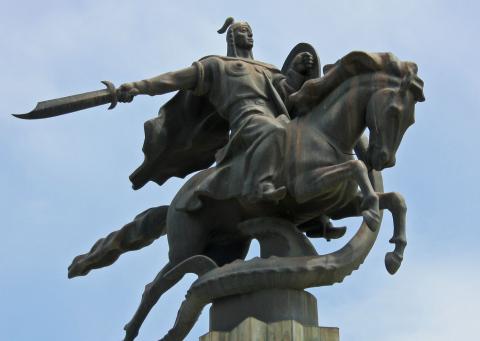
I’d like to thank Alex for giving me the opportunity to blog on HIGH-ALERT. From time to time I’ll interrupt the news feed with insights from my travels ‘off the map’. For the moment, I shall speak a bit about the Republic of Kyrgyzstan. I’m here in the capital city of Bishkek for approximately two days now and will be here until the end of December carrying out a collective action game with a community nearish a large lake called Issyk-kul.
As for me, I am working on a PhD at McGill, in the study of ecological economics, or how to develop a totally new system of exchange and the associated social and political institutions that go with it which respects the capabilities of all human beings to achieve basic needs without extracting materials or waste that extend beyond the Earth’s capacity to regenerate or assimilate them.
This bit of research will question the assumed homo economicus response towards protecting nature or the collective commons through a variety of different payment types (including no payment at all). This is particularly important in societies that are traditionally communitarian (in the case of Kyrgyzstan, as generations of nomadic peoples followed by forced Soviet collectivization) that are transitioning ever so slowly to market economies. That being said, I will try not to talk about the academic side of my travels too much- but feel free to email me if you want to know more!
So first of all, you’re probably wondering where on earth is Kyrgyzstan. It is as land-locked as a habitable place on Earth can get. The Republic of Kyrgyzstan is a relatively ‘new’ country, becoming independent from the former USSR in 1991. Since independence, it has remained economically and in many ways politically tied to Russia and has had to deal with a number of ethnic conflicts that almost escalated to civil war in 2010. The population is a combination of ethnicities, from Uighurs, to Kyrgyz, Tajiks, and Slavic Russians to Chinese Muslims (known as Dungans). There are also smaller populations of Soviet South Koreans and expat Turks.

As I peered out the window of the plane leaving Istanbul two days ago, the clouds below disappeared to reveal an endless dry grassland in all directions. It was no ordinary grassland though! From 9000 metres above the earth flying out from the Caspian Sea over Turkmenistan and Uzbekistan, the land looked positively pockmarked. It was almost as if the desiccated savanna had been impacted by miniature craters. Nowhere below was there any sign of habitation- though maybe I was too high up to notice anything.
As we neared to land, the land below looked a lot more like the Canadian prairies, with flat irrigated fields and small neighbourhoods of clustered houses.
My first couple days have been fraught with jetlag and a general daze- but I did get a chance to walk over to the office where I’ll be based for my research as well as the main central square of the city of Bishkek. My first impression is of a feeling of European coziness, with very tall poplars and elms lining the streets; of terraced cafes and small markets selling Russian-style breads and pastries. There are large soviet-style tower blocks and city squares that echo in their vastness and eerie mid-century antiquity.
Though despite the European veneer, the many Kyrgyz themselves have Mongolian features, reminding me that I am very much in Asia. My big challenge now is to learn Russian and of course to learn and share as much as I can about this unique and little known society.
(accompanying photo of Manas courtesy of neiljs)